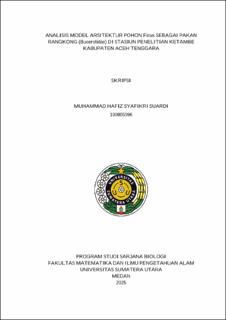Analisis Model Arsitektur Pohon Ficus Sebagai Pakan Rangkong (Bucerotidae) Di Stasiun Penelitian Ketambe Kabupaten Aceh Tenggara
Architectural Analysis Of Ficus Trees As Feeding Resources For Hornbills (Bucerotidae) In Ketambe Research Station, Southeast Aceh

Date
2025Author
Suardi, Muhammad Hafiz Syafikri
Advisor(s)
Pasaribu, Nursahara
Metadata
Show full item recordAbstract
Tree architectural model is a key characteristic that influences ecosystem dynamics, particularly in relation to hornbills (Bucerotidae). Ficus, as the primary food tree for hornbills, exhibits architectural variations that may affect its utilization by hornbills in the Ketambe Research Station. This study aims to identify Ficus species and their architectural models, analyze hornbill preference for tree architectural models, and compare tree characteristics based on hornbill presence. Data collection was conducted using the Line Transect method. Research methods included Ficus surveys, tree architectural classification, hornbill observations, geospatial mapping, and environmental factor assessment. Data were analyzed through vegetation analysis, spatial analysis using QGIS software, and preference tests using Jacob’s Index and the Chi-square test. The results showed 8 Ficus species with 33 individuals, categorized into 2 architectural models: Rauh and Troll. 4 hornbill species were recorded, with 192 encounters. Jacob’s Index value (D = 0.08) indicated a weak preference for the Rauh model, while the Chi-square test (p = 0.6705) showed no significant difference between the two models. However, a descriptive association between tree architectural models and hornbill presence was observed through architectural variables of the trees.
Collections
- Undergraduate Theses [984]
